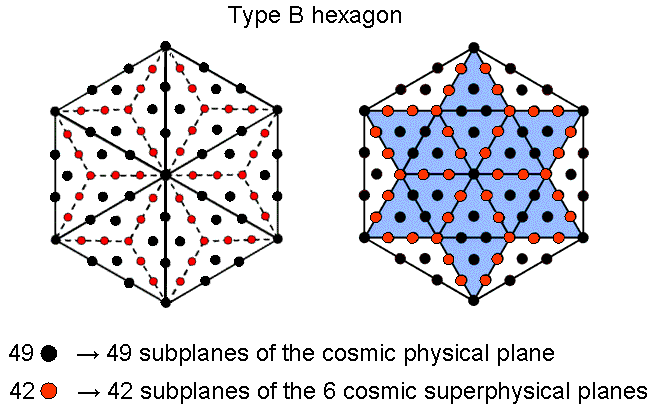 As an example of the hidden knowledge that is revealed by the tetractys to be embodied in
sacred geometries and various polygons, the Type B hexagon contains 91 yods, where
As an example of the hidden knowledge that is revealed by the tetractys to be embodied in
sacred geometries and various polygons, the Type B hexagon contains 91 yods, where| << Previous 1... 2 3 4 [5] 6 Next >> |
 As an example of the hidden knowledge that is revealed by the tetractys to be embodied in
sacred geometries and various polygons, the Type B hexagon contains 91 yods, where
As an example of the hidden knowledge that is revealed by the tetractys to be embodied in
sacred geometries and various polygons, the Type B hexagon contains 91 yods, where
91 = 12 + 22 + 32 + 42 + 52 + 62.
As the hexagon is the fourth of the regular polygons, the Tetrad Principle picks out the very polygon whose yod population measures all the levels of consciousness. For each yod symbolizes one of the 91 subplanes of the seven cosmic planes. The 91 yods are made up of 49 black yods, either on sides of sectors of the hexagon or at the centres of its 18 tetractyses, and 42 red hexagonal yods on sides of the latter. The former symbolize the 49 subplanes of the cosmic physical plane and the latter symbolize the 42 subplanes of the six cosmic superphysical planes. The centre of the hexagon and its six corners denote the seven subplanes of the physical plane. The remaining 42 black yods denote the 42 subplanes of the six higher planes in the cosmic physical plane. The same 49:42 pattern is created by the Star of David/Sign of Vishnu shape formed by yods in the hexagon. The black yod at the centre of the hexagon denotes the lowest subplane of the physical plane, the six black yods at its corners denote the six other subplanes of the physical plane as discussed in Theosophy and the remaining 84 yods denote the 84 subplanes of superphysical planes (black yods denote cosmic physical subplanes; red yods denote cosmic superphysical subplanes). The Type B hexagon is the single, polygonal counterpart of the Cosmic Tetractys. It is discussed also here. Properties of the Type A and Type B hexagon are discussed here. As one might expect, the number 91 is one of the defining parameters of holistic systems. Its embodiment in the Type B hexagon illustrates the Tetrad Principle formulated in Article 1, for the hexagon is the fourth of the regular polygons, and holistic parameters are always either the fourth member of a class of numbers or numbers that are embodied in the fourth member of a class of geometrical objects. The number 6 is the fourth smallest integer that can be represented by the corners of a polygon, and the fact that the shape of the hexagon manifests so often in nature, e.g., it is the shape of ice crystals, the lattice of atoms in graphite and the ring of carbon atoms in the benzene molecule that forms the basis of aromatic hydrocarbons, bears powerful testimony to the ubiquitous working of the Tetrad Principle. Indeed, the carbon atom itself is composed of six electrons bound to a nucleus made up of six protons and six neutrons! Curiously, carbon is the sixth most abundant element in the universe (see here). The number 6 plays a pivotal role in determining not only the number of subplanes of consciousness but also the electron and nuclear structure of the very chemical atom that is the basis of life on Earth.
| << Previous 1... 2 3 4 [5] 6 Next >> |